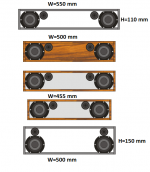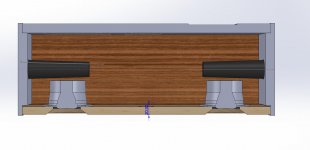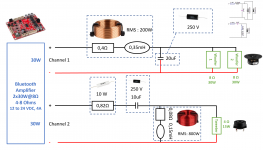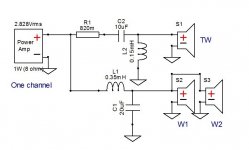Hello everybody,
As I learn how to build my first speaker (Bluetooth, table top), I come up with a few questions I struggle finding answers to on internet.
I hope the experts of this forum could help me on that project 🙂
The speaker would be made of 2 full range woofers on the side of the front panel and a tweeter in the middle.
Woofers : Dayton Audio RS100-4 4" Reference Full-Range Driver 4 Ohm
Dayton Audio RS100-4 4" Reference Full-Range Driver 4 Ohm
Tweeters : Dayton Audio ND25FA-4 1" Soft Dome Neodymium Tweeter
Dayton Audio ND25FA-4 1" Soft Dome Neodymium Tweeter
=> I chose Dayton audio speaker because they seem to be of good quality and the ZMA/FRD files are easy to find on parts express. Do you know where I could find those files for other brands ?
_____
Next step, I believe I am on the good path for the crossover design.
Looking at the graph generated by VituixCAD, do you see any problems I would have missed ?
CROSSOVER.PNG
=> Regarding to the power of the amp, is a Bluetooth board from Dayton with 2x50W enough ?
Dayton Audio KAB-250v3 2x50W Class D Audio Amplifier Board with Bluetooth 4.0
____
Now I start looking at the enclosure design with WinISD.
=> The biggest question I don't find answer to is : What is physically the difference between the alignment type ? What does it represents ?
I understand that it has different effects on the low frequencies responses but what does it mean in terms of speaker building ?
=> For such a speaker, do I need to care about temperature raise ? Do I need to have radiators need to electrical components ?
=> I plan to have two vents on the back of the case. Will it make a big difference compared to what will be calculated by WinISD ?
=> Last question, does WinISD automatically substract the volume of the vents ?
I hope you could help me on those questions, it would be a great step for me .
Have a nice day 🙂
As I learn how to build my first speaker (Bluetooth, table top), I come up with a few questions I struggle finding answers to on internet.
I hope the experts of this forum could help me on that project 🙂
The speaker would be made of 2 full range woofers on the side of the front panel and a tweeter in the middle.
Woofers : Dayton Audio RS100-4 4" Reference Full-Range Driver 4 Ohm
Dayton Audio RS100-4 4" Reference Full-Range Driver 4 Ohm
Tweeters : Dayton Audio ND25FA-4 1" Soft Dome Neodymium Tweeter
Dayton Audio ND25FA-4 1" Soft Dome Neodymium Tweeter
=> I chose Dayton audio speaker because they seem to be of good quality and the ZMA/FRD files are easy to find on parts express. Do you know where I could find those files for other brands ?
_____
Next step, I believe I am on the good path for the crossover design.
Looking at the graph generated by VituixCAD, do you see any problems I would have missed ?
CROSSOVER.PNG
=> Regarding to the power of the amp, is a Bluetooth board from Dayton with 2x50W enough ?
Dayton Audio KAB-250v3 2x50W Class D Audio Amplifier Board with Bluetooth 4.0
____
Now I start looking at the enclosure design with WinISD.
=> The biggest question I don't find answer to is : What is physically the difference between the alignment type ? What does it represents ?
I understand that it has different effects on the low frequencies responses but what does it mean in terms of speaker building ?
=> For such a speaker, do I need to care about temperature raise ? Do I need to have radiators need to electrical components ?
=> I plan to have two vents on the back of the case. Will it make a big difference compared to what will be calculated by WinISD ?
=> Last question, does WinISD automatically substract the volume of the vents ?
I hope you could help me on those questions, it would be a great step for me .
Have a nice day 🙂
First things first. You are building a 2 way speaker with 2 of 4 ohm woofers in parallel (!!! a little better than a dead short) and a tweeter. Instead have one 4 ohm woofer and one tweeter crossed at 3 kHz for one channel.
Paralleling 4 ohm woofers cuts the total impedance in half, meaning current will increase twice as much. This can possibly lead to electronics failure or trigger its short circuit protection while the condition lasts. The fun is in getting the stereo to play nicely. 🙂
Ok thanks !
To be honest, the reason I want two woofer is for design. I want to have a symetrical speaker (from left to right).
What would be the solution to keep two woofers and avoid the problem you mention ? Change the resistance of the woofer ?
To be honest, the reason I want two woofer is for design. I want to have a symetrical speaker (from left to right).
What would be the solution to keep two woofers and avoid the problem you mention ? Change the resistance of the woofer ?
I am not quite sure I follow you. Draw a simple sketch and post a crossover that you simulated. Usually when I think of a stereo boombox, this is how it should look like, imo. Each side (one woofer + one tweeter) is a two way speaker powered by one channel of an amp.
Attachments
Either wire those two 4 ohm woofers in series (8 ohm load) or get the 8 ohm version and wire them parallel (4 ohm load) if your amp can handle that. As you have it now it is a 2 ohm load and for sure your amp won't like that.
You need apply baffle diffraction to those responses before you model the response. I can see from the transfer function you have no baffle step compensation.
You need apply baffle diffraction to those responses before you model the response. I can see from the transfer function you have no baffle step compensation.
Hello,
Thank you for your answer, it helps.
What is baffle step diffraction and how do I apply it ?
Based on your comment I changed the speaker and modified the crossover.
The Woofers are now Dayton RS125P-8 and the tweeter is a Dayton ND20FB-4.
Woofers : Dayton Audio RS125P-8 5" Reference Paper Woofer 8 Ohm
Tweeter : Dayton Audio ND20FB-4 Rear-Mount 3/4" Soft Dome Neodymium Tweeter.
The enclosure and ports size are calculated. I just wonder one thing : Do I need to substract the volume of the ports to the volume of the box on WinISD ?
Here is a screenshot of the crossover I draw. => https://i.postimg.cc/T1tLCYD5/CROSSOVER-RS125-P-8.png
I could get a flatter response but I wanted to stay simple for my crossover (not to get to higher order of cross).
About the phase, I’m not sure my crossover is OK. It is not perfectly aligned, what would be the consequence on the sound ?
Looking at the graphs, do you see any mistake I would have missed ?
I’m new to this and I wish to learn.
In this picture, I tried to illustrate the crossover to better understand it and consider everything. Is it drawn ok ?
https://i.postimg.cc/Wpddvjg8/CROSSOVER-DRAWN.png
I also added the main charateristics of the components, do you see anything wrong ? For exemple, I’m not sure about resistor with a 10W rating. Does it mean that only 10W can go through the resistor ?
I have seen a differents kind of crossover for a 2 way bluetooth system like mine, is that a better way to do it ?
https://i.postimg.cc/mkyqnKLH/OTHER-CROSSOVER.png
I’m mechanical engineer and I’m new to electricity/electronics matters,
Your advices would be a great help to my project.
Have nice day.
Thank you for your answer, it helps.
What is baffle step diffraction and how do I apply it ?
Based on your comment I changed the speaker and modified the crossover.
The Woofers are now Dayton RS125P-8 and the tweeter is a Dayton ND20FB-4.
Woofers : Dayton Audio RS125P-8 5" Reference Paper Woofer 8 Ohm
Tweeter : Dayton Audio ND20FB-4 Rear-Mount 3/4" Soft Dome Neodymium Tweeter.
The enclosure and ports size are calculated. I just wonder one thing : Do I need to substract the volume of the ports to the volume of the box on WinISD ?
Here is a screenshot of the crossover I draw. => https://i.postimg.cc/T1tLCYD5/CROSSOVER-RS125-P-8.png
I could get a flatter response but I wanted to stay simple for my crossover (not to get to higher order of cross).
About the phase, I’m not sure my crossover is OK. It is not perfectly aligned, what would be the consequence on the sound ?
Looking at the graphs, do you see any mistake I would have missed ?
I’m new to this and I wish to learn.
In this picture, I tried to illustrate the crossover to better understand it and consider everything. Is it drawn ok ?
https://i.postimg.cc/Wpddvjg8/CROSSOVER-DRAWN.png
I also added the main charateristics of the components, do you see anything wrong ? For exemple, I’m not sure about resistor with a 10W rating. Does it mean that only 10W can go through the resistor ?
I have seen a differents kind of crossover for a 2 way bluetooth system like mine, is that a better way to do it ?
https://i.postimg.cc/mkyqnKLH/OTHER-CROSSOVER.png
I’m mechanical engineer and I’m new to electricity/electronics matters,
Your advices would be a great help to my project.
Have nice day.
I was wondering, where did you plan to put the other 2 woofers, since you decided to have two 8 ohm units in parallel? From your drawing, there seem no provisions for this.
You can probably apply baffle step response in the very simulator (Vituixcad?) that you are using which is a change in spl introduced by the baffle (enclosure side where the speaker units are) size and shape. There has to be an option of using the enclosure where you can define its measures, for now it appears that you haven't this feature employed.
You can probably apply baffle step response in the very simulator (Vituixcad?) that you are using which is a change in spl introduced by the baffle (enclosure side where the speaker units are) size and shape. There has to be an option of using the enclosure where you can define its measures, for now it appears that you haven't this feature employed.
Last edited:
Hello,
What do you mean by "the other 2 woofers" ? I plan to have 2 Dayton RS125P on the side of the front panel, you can see them on the picture of my last reply. The tweeter is no represented but would be in the middle of the front panel.
Regarding to the port tubes, do their position seem ok to you ?
Thank for the baffle step diffraction, I will look for a tutoriel on how to apply this with Vituix.
About the crossover, does it seems ok ? Do you see anything shocking ?
Thanks
What do you mean by "the other 2 woofers" ? I plan to have 2 Dayton RS125P on the side of the front panel, you can see them on the picture of my last reply. The tweeter is no represented but would be in the middle of the front panel.
Regarding to the port tubes, do their position seem ok to you ?
Thank for the baffle step diffraction, I will look for a tutoriel on how to apply this with Vituix.
About the crossover, does it seems ok ? Do you see anything shocking ?
Thanks
Wait a second about the crossover, this is not yet finished since there is no baffle step applied yet. It is not clear how you are planning to power the units. Draw a schematic by hand and show us exactly which amplifier channel goes where.
No, you are not supposed to wire drivers like that. Each channel powers both of the woofers and a tweeter at the same time, if you still persist on using woofers in parallel. I have already explained earlier how you can organize drivers in the baffle.
edit: search for the thread VituixCAD in Design & Build forum, Software Tools subforum and ask there about how to apply baffle step response.
edit: search for the thread VituixCAD in Design & Build forum, Software Tools subforum and ask there about how to apply baffle step response.
Attachments
Last edited:
Ok so you recommend having two separate channel with a woofer and a tweeter for each ? And then, a crossover for each ?
What's the advantage ?
When simulating, I saw that having 2 woofers in parallel allowed me to increase their SPL and nearly match the tweeter's SPL. Is that wrong ?
Sorry I know it's a lot of questions but I'm trying to really understand thing (A book is on a way to help also).
Thanks
What's the advantage ?
When simulating, I saw that having 2 woofers in parallel allowed me to increase their SPL and nearly match the tweeter's SPL. Is that wrong ?
Sorry I know it's a lot of questions but I'm trying to really understand thing (A book is on a way to help also).
Thanks
In order for a stereo to work as intended, you should be able to hear the information recorded on each channel in an extent as full as possible and you can not achieve that if you wire only a single tweeter to one, and woofers to another channel. The rest of the band not covered by a speaker unit would be filtered out. Number of speaker units in a boombox is a matter of one's own decision. You can have anything you want, bearing in mind that a certain combination is sensible in respect to impedance and total spl.
Alternately, Gaussem, if you want to use the three driver setup instead of having two tweeters as well, you could select a mono amplifier module. In my experience, bluetooth speakers aren't usually wide enough to experience any real stereo effects, so you really wouldn't be losing anything by going to a mono setup. It also removes the complication that no one has yet mentioned, that being that for stereo bass configurations the chambers for the two drivers should be separated to maintain clarity. I don't know that the amp module you've been looking at can be configured to run in mono mode, but I'm sure if you sent an email to the PE tech team they'd be happy to help you figure that out.
Ok thank you for you comment. I was wondering if the there would a true stereo effect since the box is only 45cm wide. I might go for the mono amp as you suggest. It would be less expensive with 1 tweeter and 1 crossover less.
Though, does a "stereo" configuration would improve the directivity of the system ?
In that configuration, what do you think about the crossover I added in one of my previous messages ? Do you see anything wrong with phase or impedance ?
Lojzek thanks for your message. What rule do you apply to be "in respect with impedance and total SPL" ?
Though, does a "stereo" configuration would improve the directivity of the system ?
In that configuration, what do you think about the crossover I added in one of my previous messages ? Do you see anything wrong with phase or impedance ?
Lojzek thanks for your message. What rule do you apply to be "in respect with impedance and total SPL" ?
- Status
- Not open for further replies.
- Home
- Loudspeakers
- Multi-Way
- First DIY bluetooth speaker



